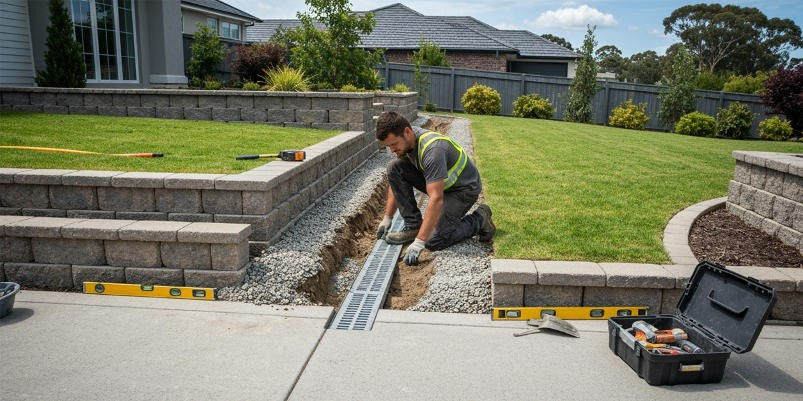How to Know If Your Entrance Is Hurting Drainage
- linda39531
- Aug 6
- 4 min read

Table of Contents
Why Your Entrance Might Be the Problem
Most folks think of their entrance as just a place to walk or drive through. But it plays a bigger part than that. It can help move water away from your property. Or it can send it straight into trouble.
One small slope or a misplaced edge can turn your front area into a water trap. If that happens, you’re not just dealing with a wet patch. You’re risking cracked pavement, a soggy yard, or worse, water seeping into places it doesn’t belong.
So yes, the entrance matters. Ignore it, and you could be setting yourself up for some messy repairs.
Signs That Water Isn’t Draining Right
You don’t need a shovel or a level to spot the signs. Just look around after it rains.
Here’s what to watch for:
Puddles that stick around too long
Grass that stays wet for days
Water creeping toward your house or garage
Dirt washing down your driveway
Slimy stuff on concrete or steps
Cracks showing up in your walkway or drive
If you see any of these, your entrance might be getting in the way of proper flow. It doesn’t mean the whole system is failing. But it means something isn’t right.
What a Bad Entrance Does to Your Drainage
Drainage works best when water moves where it’s supposed to. That means away from your home. Away from your foundation. Into safe spots like swales, ditches, or storm lines.
But a poorly built or aging entrance can slow that water down. Sometimes it stops the water cold.
And when water gets stuck, it spreads. It soaks the soil. It leaks into cracks. It can even backflow into your garage or basement.
Your entrance could be sloped the wrong way. It might be blocking a drain. Or it might be built with materials that don't let water pass.
All of this causes problems with your drains and drainage system. When that system stops working right, the rest starts going downhill too.
Things That Make the Situation Worse
You’d be surprised how often people try to fix drainage with quick tricks. Sadly, most of them just make things worse.
Here are some common blunders:
Piling gravel where water collects
Laying bricks or boards to push water back
Covering old drains without checking them
Pouring new concrete without adjusting slope
Blocking the sides of driveways with dirt or plants
A major miss is ignoring how water moves when it rains hard. A dry-day fix means nothing if the water still flows the wrong way when it pours.
And don't forget winter. Ice buildup near your entrance could mean hidden drainage problems under the surface.
Fixes You Can Try Before Digging Up the Yard
The good news is you may not need to tear it all up. A few simple fixes can help you avoid big costs and wasted time.
Start with this:
Look at your slope. It should lean away from your home. Even a small angle helps.
Clear edges. Water needs a clean path to drain off. Don’t block it with heavy borders or raised flower beds.
Use the right ground cover. Permeable gravel or well-set pavers let water soak through instead of pooling.
Add trench drains or grates near problem spots. These collect and guide water before it spreads.
If the problem feels small now, fix it before it grows big.
How Pros Like Barfoot Contracting Handle It
If your entrance is flooding or causing damage, it may be time for help. Some problems go deeper than the surface.
At Barfoot Contracting, we don’t guess. We check slope, material, ground movement, and how your full layout affects flow. Our crew uses machines like excavators, graders, and dump trucks to get it right the first time.
We fix slopes, adjust grading, and even dig out or rebuild full entranceways if needed. Our team can trench new lines, rework edges, and tie the area back into your full drainage layout.
We’ve been doing this work for over 25 years. So we know what to look for, and how to solve it without wasting time or cutting corners.
Wrap Up: Ready to Protect Your Property
If your entrance is making things worse instead of better, don’t wait for more damage. One blocked drain or one wrong slope can cause major trouble.
At Barfoot Contracting, we help fix that. We handle drainage problems at the root. No guesswork. No half-fixes.
We’ve served Grey Bruce and Owen Sound homes for years. Our equipment is sharp. Our crew is fast. And our goal is simple: get your job done right.
Let’s look at your entrance. Let’s fix the water. And let’s make sure your property stays dry and strong through every season.
FAQs
What’s the first spot I should check if water collects near my entrance?
Start at the low points along the edge. That’s where water tries to escape. If there’s dirt, debris, or raised borders, you’ve found the likely cause.
Can the type of driveway affect drainage problems at the entrance?
Yes. Concrete, asphalt, and interlock all handle water differently. Some soak water. Others push it. The way it’s installed matters too.
Is entrance drainage still important on flat land?
Absolutely. Even flat ground needs direction. Without a slope or escape path, water just sits. That’s where most long-term problems begin.
What signs mean the entrance is shifting or sinking?
Cracks, dips, or spots where water always collects. You may also see gaps between your entrance and steps or walkway.
Does clearing snow affect how water drains near the entrance?
Yes. Pushing snow to the wrong side or packing it too tight can block paths where water normally drains after melting.
Call Barfoot Contracting Today
Let’s check your entrance. Fix what’s wrong. And get your water flowing where it should. Simple work. Real results. No stress.




Comments